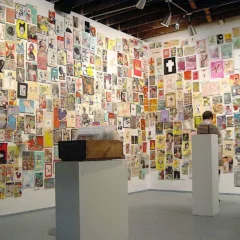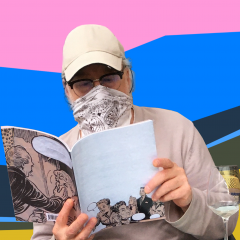[This is part 3 of a multi-part article.]
Hatching plans
Jack Early and Rob Pruitt met in their early 20s while studying art at the Corcoran School in Washington, D.C. The two quickly hatched plans to hit it big in the other capital – New York City. The moment they’d finished school, the young artists hustled over to Andy Warhol’s Factory. They thought they had the necessary irony and media savvy to seduce the wigged one and join up with the biggest show in New York. Unfortunately Andy only offered them only gopher jobs without pay. That strategy wasn’t going to work, and staying at the Chelsea Hotel was going to get expensive if they spent all their money behaving like artists and not making any art.
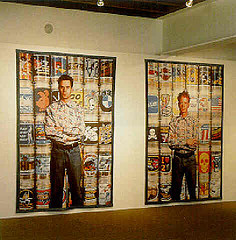
Miller Wall Diptych, (detail, cans) Rob Pruitt & Jack Early 1990 Weatherspoon, Art Museum, Greensboro, North Carolina
As it turned out, the duo had to return home to rethink their plans, and get more cash. Back in North Carolina, Early read the inspiring Calvin Tomkins’ Off The Wall about the early careers of Rauschenberg, Johns and other young artists in the 1950s, how they did storefront windows and scraped for every dime in order to have a studio in which to work. Early had the idea to return to New York and beg a job at Leo Castelli’s gallery on West Broadway. As it turned out, a friend of a friend was leaving Castelli’s and Early quickly presented himself as the perfect replacement. “I said my friend had sent me,” Early remembered. “But I knew he’d been fired for dropping a Lichtenstein on the floor.”
Working at the gallery had distinct advantages – like meeting some of America’s most well known artists, including Richard Artschwager. The two began talking and Early agreed to help the artist with building some new pieces and restoring older, damaged ones. “Hell, I didn’t even know how to use a hammer,” he said. “I kept calling him Schwarzenegger, too, which he didn’t care for.” Actually Richard didn’t like me at all, but I did learn quick and I liked Richard so much…in the end, he kind of grew to like me.” Early didn’t want to lose the great pay either – who else would allow him to do what he wanted and live in New York City? A dream come true. While under Artschwager’s wing, Early saw the world, traveling to Paris, Madrid and Germany, eventually working on the front lines for the artist, installing shows, managing the business, and dealing with dealers. “It was a very good life,” he recalled. “Richard saw himself as a farmer, and when the weather was good the farmer’s helpers ate well.”
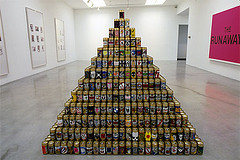
PAINTBALL: PRUITT/EARLY (pyramid)
Installation view at Stuart Regen Gallery
June 4 – June 29, 1990
But by the end of the 1980s, Early was ready to fly the coop to work full time on his own art with Rob Pruitt, who had lived a vaguely parallel life at the Sonnabend Gallery. Between the two they generated a fat Rolodex and an easy way amongst the better downtown galleries. They were also working tirelessly on the next big thing. Clearly they took their cues from the Elvis Presley of the ’80s art world, Jeff Koons. Pruitt and Early’s Art for Teenage Boys reflected the emptiness of their own generation, using six packs of beer stacked high off the floor and wooden cutouts of Camarros and Harleys.
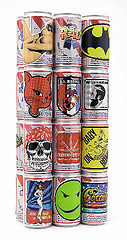
Pruitt-Early (Rob Pruitt, Walter “Jack” Early) (detail, cans)
Artworks for teenage boys, 1980, Mixed Media Sculpture w/beer cans & decals
19 x 8.7 x 6.5 in. / 48.2 x 22 x 16.5 cm.
“We explored the visual culture of teenaged boys,” said Early about their debut show at Soho’s 303 Gallery. Indeed it was an iconic ’80s installation: A galvanized bathtub brimming with plastic ice and even more beer, the six-pack sculptures, head shop stickers, silkscreen paintings of heavy metal idols and iron-on motorcycle logos “was accessible to anyone!” In fact Pruitt•Early, as the team called itself, put on an exhibition that was not too distant from a 7-Eleven. ”It’s like watching television,” Early explained. Not exactly an Artschwager exhibition but clearly something new in the mold of Warhol. Videos made by the duo also shown featured artists Richard Prince, John Baldassari and art dealer, Morgan Spangle. Spangle, former Leo Castelli director and (then) co-owner of RubinSpangle, sang the Rolling Stones’ “Satisfaction” at Macy’s Herald Square. Art collectors couldn’t resist it and the two were on a roll. Next stop was not the back room at Castelli’s but the entire gallery (1991).
The real lives of artists
“Richard Artschwager helped me with me,” Jack said. “In college I tried to visualize what life would be like if I were an artist. Working for an artist I admired I realized he still had to cut the grass and fix the sink, leading a normal life. Even Ashley Bickerton said to me he was surprised to see Richard standing in line at the hardware store. He didn’t think famous artists had to stand in line.”
Meyer said practically the same thing about his relationship with Johns – his “job” entailed everything except “painting or drawing on the canvases – Jasper erased marks I’d made and redrew them.” His day began anywhere from working on casts for sculptures or preparing prints at ULAE (one of Johns’ printers in NYC and one of the galleries Meyer has since hooked up with). In the studio Meyer would repair paintings for collectors, prepare lunch, drive to the studio in Upstate New York, take care of Binha, Johns’ dog, or deal with visitors – a roster of buyers, friends, art dealers and other artists. “Is there a cute little helper who serves tea and cookies and fetches prints for collectors?” laughed Meyer. “You’re looking at him.”
[Read more of this story in Part 1, Part 2 and Part 4].
Matthew Rose is an artist and writer living in Paris, France. His next exhibition will feature his “Scribble Drawings” at the 20/21 International Art Fair with the Art Vitam Gallery at the Royal College of Art, London 22-25 February, 2007.



